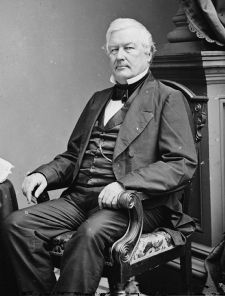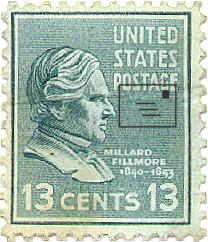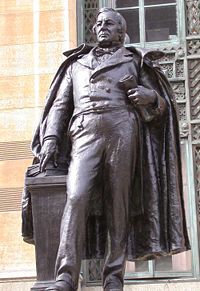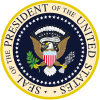Millard Fillmore
| Term of office | July 9, 1850 – March 3, 1853 |
| Preceded by | Zachary Taylor |
| Succeeded by | Franklin Pierce |
| Date of birth | January 7, 1800 |
| Place of birth | Summerhill, New York |
| Date of death | March 8, 1874 |
| Place of death | Buffalo, New York |
| Spouse | Abigail Powers Fillmore (1st wife) Caroline Carmichael McIntosh (2nd wife) |
| Political party | Whig |
Millard Fillmore (January 7, 1800 – March 8, 1874) was the thirteenth President of the United States, serving from 1850 until 1853, and the last member of the Whig Party to hold that office. He succeeded from the Vice Presidency on the death of President Zachary Taylor, who died of acute gastroenteritis, becoming the second United States vice President to assume the office after the death of a sitting president. Fillmore was not elected President in his own right. After serving out Taylor's term he was not nominated for the Presidency by his party, the Whig Party in the U.S. presidential election, 1852. In 1856 he failed to win election as President standing for office as the Know Nothing Party candidate.
While Fillmore is considered one of the lesser U.S. presidents, it needs be remembered that his statesman support of the Compromise of 1850 that forestalled the American Civil War for ten years. He also dispatched an expedition to Japan of U.S. Navy vessels under the command of Commodore Matthew C. Perry. This expedition proved hugely successful in opening and broadening trade with Japan.
Early life
Fillmore was born in poverty to Nathaniel Fillmore and Phoebe Millard Fillmore in the frontier town of Locke (now Summerhill), New York as the second of nine children and the eldest son. His parents had migrated from New England before his birth. The Fillmores made their living as tenant farmers. Millard spent his youth working along-side his father. He was first apprenticed to a cloth-maker to learn the clothmaking trade when he was fifteen years old. He struggled to obtain an education under frontier conditions memorizing words from a dictionary while operating machinery in the millworks where he was apprenticed. When he was 18 years old, Fillmore moved to Buffalo, New York to continue his studies. He bacame a law clerk toi a county judge, where he got his early introduction to the law. He was admitted to the bar in 1823 and began his practice of law in East Aurora in Erie County, New York.
In 1826 he considered himself financially secure enough Fillmore married Abigail Powers, daughter of Reverend Lemuel Powers. The couple had two children, Mary Abigail and Millard Powers.
In 1828, he was elected to the New York legislature and served from 1829 to 1831. In 1830 he moved his family to Buffalo, NY and soon became one of the leading lawyers there.
Early political career
Fillmore was elected as a Whig to the Twenty-third United States Congress (1833-1835); he was also elected to the Twenty-fifth United States Congress|, Twenty-sixth United States Congress and Twenty-seventh United States Congress (1837-1843). He declined to be a candidate for renomination in 1842. He was an unsuccessful candidate forgovernor of New York in 1844. He was state comptroller of New York from 1847 to 1849.
Vice-Presidency
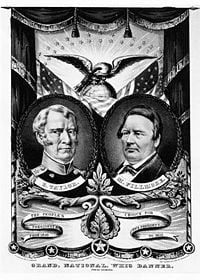
Having worked his way up through the Whig Party in New York, Fillmore was selected as Zachary Taylor's running mate. (It was thought that the obscure, self-made candidate from New York would complement Taylor, a slave-holding military man from the south.)
Taylor and Fillmore disagreed on the slavery issue in the new western territories taken from Mexico in the Mexican-American War. Taylor wanted the new states to be free states, while Fillmore supported slavery in those states as a means of appeasing the South. In his own words: "God knows that I detest slavery, but it is an existing evil ... and we must endure it and give it such protection as is guaranteed by the Constitution."
Fillmore presided over the Senate during the months of nerve-wracking debates over the Compromise of 1850. He made no public comment on the merits of the compromise proposals, but a few days before President Taylor's death, Fillmore suggested to the president that, should there be a tie vote on Henry Clay's bill, he would vote in favor of it.
Presidency 1850–1853
Policies
Fillmore ascended to the presidency upon the sudden and unexpected death of President Taylor in July 1850. The sudden change in leadership also signalled an abrupt political shift in the administration. Taylor's cabinet resigned and Millard Fillmore at once appointed Daniel Webster to be Secretary of State, thus proclaiming his alliance with the moderate Whigs who favored the Compromise.
A bill to admit California to the Union still aroused all the violent arguments for and against the extension of slavery without any progress toward settling the major issues. Clay, exhausted, left Washington to recuperate, throwing leadership upon Senator Stephen A. Douglas of Illinois. At this critical juncture, Millard Fillmore announced his support of the Compromise of 1850.
On August 6, 1850, he sent a message to Congress recommending that Texas be paid to abandon her claims to part of New Mexico. This helped shift a critical number of northern Whigs in Congress away from their insistence upon the Wilmot Proviso—the stipulation that all land gained by the Mexican War must be closed to slavery.
Douglas's effective strategy in Congress combined with Fillmore's pressure to give impetus to the Compromise movement. Breaking up Clay's single legislative package, Douglas presented five separate bills to the Senate:
- Admit California as a free state.
- Settle the Texas boundary and compensate the state for lost lands.
- Grant territorial status to New Mexico.
- Place Federal officers at the disposal of slaveholders seeking escapees—the Fugitive Slave Act.
- Abolish the slave trade in the District of Columbia.
Each measure obtained a majority, and, by September 20, President Fillmore had signed them into law. Webster wrote, "I can now sleep of nights."
Another important legacy of Fillmore's administration was the sending of Commodore Matthew C. Perry to open Japan to Western trade, though Perry did not reach Japan until Franklin Pierce had replaced Fillmore as president.
Administration and Cabinet
| OFFICE | NAME | TERM |
| President | Millard Fillmore | 1850–1853 |
| Vice President | None | |
| Secretary of State | Daniel Webster | 1850–1852 |
| Edward Everett | 1852–1853 | |
| Secretary of the Treasury | Thomas Corwin | 1850–1853 |
| Secretary of War | Charles Magill Conrad | 1850–1853 |
| Attorney General | John J. Crittenden | 1850–1853 |
| Postmaster General | Nathan K. Hall | 1850–1852 |
| Samuel D. Hubbard | 1852–1853 | |
| Secretary of the Navy | William A. Graham | 1850–1852 |
| John P. Kennedy | 1852–1853 | |
| Secretary of the Interior | Thomas McKennan | 1850 |
| Alexander Stuart | 1850–1853 | |
Supreme Court appointments
Fillmore appointed the following Justices to the Supreme Court of the United States:
- Benjamin Robbins Curtis - 1851
States admitted to the Union
- California – 1850
Legacy
Some northern Whigs remained irreconcilable, refusing to forgive Fillmore for having signed the Fugitive Slave Act. They helped deprive him of the Presidential nomination in 1852.
Within a few years it was apparent that although the Compromise had been intended to settle the slavery controversy, it served rather as an uneasy sectional truce.
Later life
Fillmore was one of the founders of the University of Buffalo. The school was chartered by an act of the New York State Legislature on May 11, 1846, and at first was only a medical school [1]. Fillmore was the first Chancellor, a position he maintained while both Vice President and President. Upon completing his presidency, Fillmore returned to Buffalo, where he continued to serve as chancellor.
As the Whig Party disintegrated in the 1850s, Fillmore refused to join the Republican Party; but, instead, in 1856 accepted the nomination for President of the Know Nothing (or National American) Party.
On February 10,1858, he married a widow Mrs. Caroline Carmichael McIntosh.
Throughout the Civil War, he opposed President Lincoln and during Reconstruction supported President Johnson. He commanded a corps of home guards during the Civil War.
He died at 11:10 p.m. on March 8, 1874 of the after-effects of a stroke, with his last words alleged to be, upon being fed some soup, "the nourishment is palatable." On January 7 each year a ceremony is held at his gravesite in the Forest Lawn Cemetery in Buffalo.
Trivia
- The myth that Millard Fillmore installed the White House's first bathtub was started by H. L. Mencken in a joke column published on December 28, 1917 in the New York Evening Mail. (See: Bathtub hoax)
- Having found the White House devoid of books, Millard Fillmore initiated the White House library.
- As of 2006, Millard Fillmore remains the last U.S. president who was neither a Democrat nor a Republican (although Abraham Lincoln was re-elected in 1864 running on the Union Ticket instead of as a Republican with Democrat Andrew Johnson as his running mate).
- Fillmore, Utah, located in Millard County was named after this president.
ReferencesISBN links support NWE through referral fees
See also
- Mallard Fillmore
- U.S. presidential election, 1848
- U.S. presidential election, 1856
- List of places named for Millard Fillmore
External links
- First State of the Union Address
- Second State of the Union Address
- Third State of the Union Address
- White House Biography
- Works by Millard Fillmore. Project Gutenberg
- Millard Fillmore Internet Obituary
| Preceded by: (none) |
U.S. Congressman for the 32nd District of New York 1833-1835 |
Succeeded by: Thomas Cutting Love |
| Preceded by: Thomas Cutting Love |
U.S. Congressman for the 32nd District of New York 1837-1843 |
Succeeded by: William A. Moseley |
| Preceded by: Luther Bradish |
Whig Party nominee for Governor of New York 1844 (lost) |
Succeeded by: John Young |
| Preceded by: Theodore Frelinghuysen |
Whig Party vice presidential candidate 1848 (won) |
Succeeded by: William A. Graham |
| Preceded by: George M. Dallas |
Vice President of the United States March 4, 1849(a) – July 9, 1850(b) |
Succeeded by: William R. King |
| Preceded by: Zachary Taylor |
President of the United States July 9, 1850(c) – March 3, 1853 |
Succeeded by: Franklin Pierce |
| Preceded by: (none) |
American Party presidential candidate 1856 (lost) |
Succeeded by: (none) |
| Preceded by: Winfield Scott |
Whig Party presidential candidate 1856 (lost) |
Succeeded by: (none) |
| |||||||
Template:US Vice Presidents
| Persondata | |
|---|---|
| NAME | Fillmore, Millard |
| ALTERNATIVE NAMES | |
| SHORT DESCRIPTION | 13th President of the United States, 12th Vice President of the United States |
| DATE OF BIRTH | January 7, 1800 |
| PLACE OF BIRTH | Summerhill, New York |
| DATE OF DEATH | March 8, 1874 |
| PLACE OF DEATH | Buffalo, New York |
Credits
New World Encyclopedia writers and editors rewrote and completed the Wikipedia article in accordance with New World Encyclopedia standards. This article abides by terms of the Creative Commons CC-by-sa 3.0 License (CC-by-sa), which may be used and disseminated with proper attribution. Credit is due under the terms of this license that can reference both the New World Encyclopedia contributors and the selfless volunteer contributors of the Wikimedia Foundation. To cite this article click here for a list of acceptable citing formats.The history of earlier contributions by wikipedians is accessible to researchers here:
The history of this article since it was imported to New World Encyclopedia:
Note: Some restrictions may apply to use of individual images which are separately licensed.
